(Vowed religious observances in the month of Shravan)
The mention of the Hindu lunar month of Shravan (Shravan maas) reminds us of various vrats. It is difficult for the common people to perform conducts according to the Vedas . Hence, to overcome this difficulty, the Puranas (The eighteen sacred Holy texts compiled by Sage Vyas) suggest observance of vrats. Most of these special vrats come in the month of Shravan.
1. Shravani somvar vrat (Vrat of Shravan Monday)
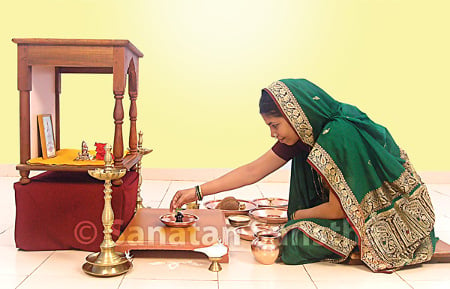
The presiding Deity to be worshipped for the vrat of Shravan Monday is Deity Shiva.
A. Ritual of vrat of Shravan Monday
In this, on every Shravan Monday, the temple of Deity Shiva is visited and He is worshipped. Some devotees of Shiva offer 108 bel (Aegle marmelos tree) leaves or bel leaves in specific number on the Shiva pindi (Deity Shiva’s sacred symbol) on every Shravan Monday. Some people visit the holy places of Shiva on Shravan Monday like Kedarnath, Kashi, Babadham, Tryambakeshwar, Gokarna etc. and worship Him with various rituals. It is beneficial to chant the Name of Shiva on the day of Shravan Monday.
B. Fasting associated with the vrat of Shravan Monday
On this day if possible, ‘nirahar’ fasting is observed. Nirahar fasting means the fasting observed only by drinking water when necessary during the day. Some people observe ‘nakta’ vrat. The period of three ghatika, that is, 72 minutes after the sunset or up to the sight of an asterism is called ‘naktakal’. The person who observes vrat does not consume anything during the day and takes food in this ‘naktakal’.
C. Some religious actions performed on Shravan Monday
At some holy places the Shiva devotees perform a Kavar journey either on any one Monday or on every Monday of the month as per their ability and offer the water carried in the Kavar on the Shiva pindi. This journey is performed on foot without using footwear.
This vrat is concluded on the fourth Monday of Shravan when at some holy places meals are offered to people. By observing this vrat, Deity Shiva is appeased and the devotee gets Shiva-sayujya mukti, which means he attains oneness with Deity Shiva. Combining with this vrat, some women observe one more sub-vrat on every Monday and it is Shivamushti vrat.
2. Shivamuth (Shivamushti vrat)
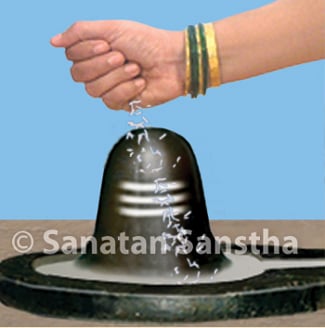
Offering a specific grain (Shivamushti) on the Shivapindi
During the first five years after marriage, the married women take a single meal on every Shravan Monday and worship the Shivalinga (Deity Shiva’s sacred symbol). Those who are not able to go to a temple and perform this ritual can make a resolve and perform this ritual at home itself.
A. Following ingredients are necessary for ritual of vrat
Copper platter, a metal glass, a small copper kalash (metal pot) called achamani; sandalwood paste to offer to Shiva, white unbroken rice-grains, white flowers and bel leaves; a lamp with a wick, incense stick, camphor, an implement to light camphor-arati, washed rice to offer to Shiva as per the day, white sesame seeds, green gram or wheat, milk for offering as Naivedya , a folded betel leaf or two betel leaves and a betel nut and some coins for offering to the priest.
B. Actual ritual of Shivamushti vrat
1. Ritual is commenced by praying to Deity Shiva.
2. Achaman is taken first.
3. Thereafter following resolve is made:
ममश्रीशिवप्रीतिव्दारासर्वोपद्रवनिरासपूर्वं
भर्तृस्नेह-अभिवृद्घि-स्थिरसौभाग्य-पुत्रपौत्र-
धनधान्य-समृद्धि-क्षेम-आयु:-सुखसंपदादि-
मनोरथ-सिद्घ्यर्थंशिवमुष्टिव्रतंकरिष्ये।
This means, I am performing this Shivamushti vrat for destruction of all harmful things, increase of affection for husband, stability of the marital state, prosperity in respect of begetting child, grandchild, great grandchild; wealth and grains; for fulfillment of wishes for welfare, longevity, pleasure, riches etc. through my unconditional love for Deity Shiva.
An expansive feeling of family bond of the newly married lady is observed in this resolve. From this it is clear which life values the Sanatan Hindu Dharma is fostering. This shows the values fostered by Sanatan Hindu Dharma on a person.
4. Now sandalwood paste kept in the copper platter is offered on the Shivapindi.
5. Thereafter the white unbroken rice grains are offered on the Shivapindi.
6. Then white flowers are offered on the Shivapindi.
7. After this, the bel leaves are offered on the Shivapindi. Thebelleaves are offered in upside down position and with the stem towards the pindi.
8. Then the washed rice grains are held in a fist and offered on the Shivapindi. While offering a handful of rice, following shlok is recited:
नम:शिवायशांतायपंचवक्त्रायशूलिने।
शृंगिभृंगिमहाकालगणयुक्तायशांभवे।।
This means I pay obeisance to Deity Shiva who is calm, with five heads, who holds a trident and who is accompanied by Gans like Shrungi, Bhrungi, Mahakal etc. and who is benevolent.
The above act of offering handful of rice is repeated five times.
9. Thereafter a lit incense-cake is waved followed by waving a lit lamp.
10. Naivedyais offered to Deity Shiva.
11. In the end one prays to Deity Shiva withbhav (Spiritual emotion)once again.
One should perform worship in this manner on every Shravan Monday by offering a specific grain on the Shivapindi.
|
Shravan Monday |
Offering a specific |
|---|---|
| First Monday | Rice is used for Shivamushti. |
| Second Monday | White sesame seeds |
| Third Monday | Shivamushti is of green gram |
| Fourth Monday | Wheat is used for Shivamushti |
If a fifth Monday falls in the month of Shravan (Shravan maas) in a year, barley is used.
3. Mangalagour vrat
‘Mangalagour’ is a Deity which bestows long life to the husband. This vrat, which consists of puja (Ritialistic worship) of the Deity Mangalagour, should be performed by a newly-wed woman. It is expected to be continued for five to seven years after marriage on every Tuesday in the month of Shravan (Shravan maas). Puja of Deity Shiva and Shri Ganapati is performed along with Gouri in this vrat.
Click here to read the Shravan Maas Vrats (Part 2)
Reference : Sanatan’s Holy Text ‘Holy festivals, Religious festivals and Vowed religious observances’

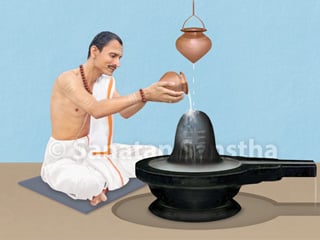 Mahashivratri 2024
Mahashivratri 2024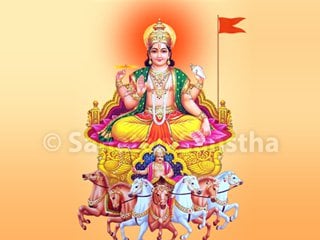 Ratha Saptami 2024
Ratha Saptami 2024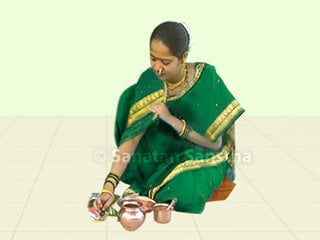 Importance of Adhik maas (Purushottam maas)
Importance of Adhik maas (Purushottam maas) Vaikunth chaturdashi is an invaluable opportunity granted to us to worship Deity Shri Vishnu
Vaikunth chaturdashi is an invaluable opportunity granted to us to worship Deity Shri Vishnu How to celebrate Navaratri in adverse times caused by coronavirus pandemic ?
How to celebrate Navaratri in adverse times caused by coronavirus pandemic ?